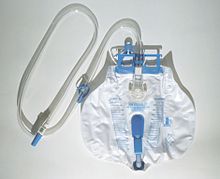Urine bags
A urine bag is a collection container for urine . It is attached to a catheter that drains urine from the bladder . Different types and sizes are offered depending on requirements.
Types of urine bags
The urine bags are available in different sizes and designs so that they meet the various requirements of the user. Special urine bags for children are also available.
Leg bag
Leg bags are used in conjunction with an indwelling catheter or a condom urinal and are used by mobile patients for daily care. Different versions are offered depending on the period of wear and type of application. For short-term use of up to 24 hours, leg bags without a fleece coating are used, while leg bags with a fleece coating are used for longer wearing times of up to three days. Special leg bags made of high quality materials and with a drip chamber can also be used for up to 14 days before they need to be replaced. Especially for wheelchair users there are leg bags that are adapted to the anatomy of the seated patient.
The leg bags have a capacity of at least 300 ml (children) or 500 ml (adults), are made of a skin-friendly material, and the connecting hose with cone is suitable for permanent catheters and condom urinals. The drain valve should be easy to use, and there should also be a graduated scale in ml to control the amount of urine released on the bag. A skin-friendly latex-free material should be used for the leg bags.
Bed bag
Bed or night bags with a drip chamber are used in conjunction with an indwelling catheter or a condom urinal. Since the risk of infection is very low with a bed bag with a drip chamber, these bed bags can be used for up to 14 days. The non-sterile bed bags are mainly used together with condom urinals, as sterile bed bags are not absolutely necessary.
The bed bags have a capacity of at least 1500 ml, the connecting hose with cone is suitable for permanent catheters and condom urinals. The bed bag should have hanging or fixing devices ( eyelets , holes, etc.), the drain valve should be easy to operate, and there should be a graduation in cm³ or ml to check the amount of urine given on the bag.
Hip pouch
The urine bags in the form of hip bags (e.g. Belly Bag ® ) are a relatively new aid and are used in conjunction with an indwelling catheter . The novel construction enables the wearer to carry the bag with a special strap directly on the hip level with the bladder. This enables very discreet care, as the catheter wearer can also wear shorts in summer without the urine bag being visible. The hip bags are delivered sterile and can be worn for up to 14 days. For night care, a bed bag can be connected to the drain valve using an adapter so that the catheter does not have to be separated from the hip bag.
The hip bags have a capacity of at least 750 ml, the antireflux valve with a cone for connecting the indwelling catheter prevents the urine from flowing back into the bladder. The drain valve should be easy to use, and there should also be a graduation in cm³ or ml to control the amount of urine released on the bag. A skin-friendly latex-free material should be used for the hip pouch.
The hip bags are not suitable for men who use an indwelling transurethral catheter (route through the urethra).
application
Different types of urine bags are used almost exclusively with condom urinals or with indwelling catheters that are placed both transurethrally and suprapubically. In certain cases, urine bags are connected to single-use catheters that were inserted as part of intermittent catheterization , for urinary retention or for diagnostics (e.g. residual urine determination ).
Urine bags for long-term care (closed systems), for example for the care of urinary incontinent patients, must not be separated from the catheter during the entire period of use, not even for bathing the patient or for taking fresh urine samples. In order to take such urine samples, these systems have their own port at the connection to the catheter.
In general, sterile urine bags are always used to prevent bacterial colonization when used together with catheters. The only exception to this is when they are used together with condom urinals; the use of sterile urine bags is not absolutely necessary here.
disposal
Used urine bags are considered contaminated waste . The emptied bags are disposed of with household waste. The bags are placed in a small garbage bag and sealed before being thrown into the household waste collection container.
literature
- Doris Friedrich: Incontinence Multiple Sclerosis: A guide to bladder and bowel disorders. Georg Thieme Verlag, 2010, ISBN 3830438281
- Brigitte Sachsenmaier: Incontinence: Help, care, and care . Schlütersche, 1991, ISBN 3-87706-329-2 .
- Mechthild Seel: Caring for people . Schlütersche , Hannover 1998, ISBN 3-87706-996-7 .
Individual evidence
- ^ Brigitte Sachsenmaier: Incontinence: Help, care, and care . Schlütersche, 1991, ISBN 3-87706-329-2 , p. 98-101 .
- ^ Brigitte Sachsenmaier: Incontinence: Help, care, and care . Schlütersche, 1991, ISBN 3-87706-329-2 , p. 99 .
- ↑ Johann Weigert: Hygiene management and infection prophylaxis. Schlütersche, 2005, ISBN 3899931483 , page 177
